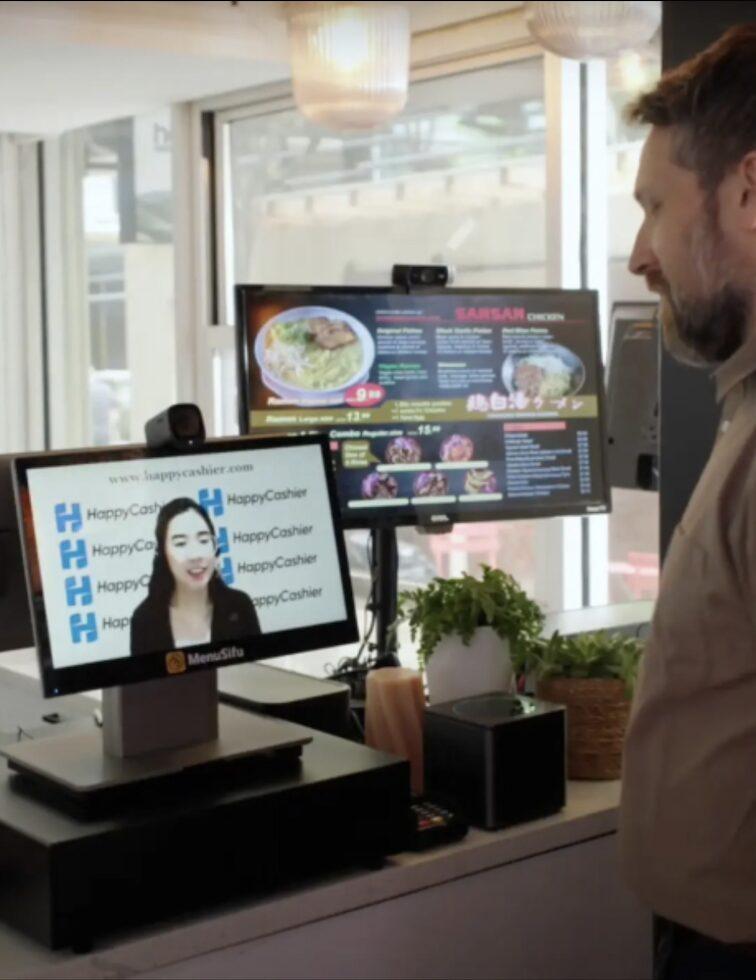A customer places an order with a virtual cashier via live video at restaurant in Manhattan. The screen connects diners with remote workers based in the Philippines—part of a growing trend in New York restaurants blending technology and hospitality. – Photo credit Happycashier.com
Inside New York’s newest dining reality, where hospitality is livestreamed across oceans
At Sansan Chicken in Manhattan’s East Village, the lunch rush begins with the glow of a screen. Customers step up to a mounted display above the register. A woman appears, wearing a headset and delivering a practiced greeting. Her voice is clear. Her manner is calm and confident. Her location? Thousands of miles away.
She’s in the Philippines.
This is the new face of service at a growing number of New York City restaurants. Through a company called Happy Cashier, fast-casual establishments like Sansan Chicken, Sansan Ramen in Long Island City, and Yaso Kitchen have outsourced their front-of-house roles to remote cashiers. These virtual workers, connected via live video feed, take orders, process payments, and engage with customers in real time—despite being on the other side of the world.
Remote Work, Real Connection
To most diners, the interaction feels seamless. Orders are placed, cards are tapped, and brief conversations unfold naturally. Only subtle cues—a mention of tropical heat, or a time zone 12 hours ahead—reveal the distance between cashier and customer.
While some patrons are surprised to learn their server is in Manila or Cebu, many describe the experience as smooth and personable. The digital setup retains the rhythm and warmth of in-person service, even across oceans.
The workers earn between $3 and $3.75 per hour, significantly below New York’s $16 minimum wage, but a livable rate in the Philippines. For restaurant owners facing persistent labor shortages and soaring operational costs, the model offers a lifeline—keeping staffing expenses low without compromising the human touch.
Service Through the Screen
Happy Cashier’s workers are not bots or AI avatars. They are live, trained professionals—many with backgrounds in hospitality or call centers—who operate during New York business hours. They’re trained to make eye contact through the camera, upsell with subtlety, and manage multi-customer flow as if they were in the room.
Customers are still prompted to tip during checkout. Although the exact split varies by establishment, tips are reportedly shared among the kitchen crew, management, and the remote cashier.
Some diners have observed that the screen-based interaction can feel more attentive than typical counter service. Despite the physical absence, the cashiers remain present in the moment—smiling, efficient, and professional.
A Shifting Service Landscape
Critics warn that outsourcing even entry-level hospitality roles contributes to the erosion of local job opportunities. Labor advocates question the long-term impact of replacing domestic roles with cheaper overseas labor, even when delivered by real people.
Happy Cashier, now active in dozens of New York restaurants and expanding rapidly, frames its mission as dual-purpose: helping small businesses survive and creating dignified jobs abroad. Its model is being adopted by restaurants seeking flexibility without sacrificing warmth.
Redefining Face-to-Face
In a city already accustomed to digital kiosks and app-based ordering, the livestreamed cashier may be the next logical step. But unlike faceless machines, these workers bring personality and presence, even through a screen.






